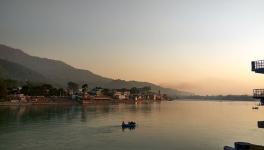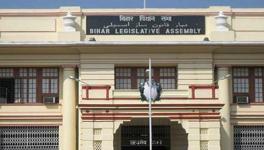Villagers Oppose Embankment on Bagmati River in Bihar
Gaighat (Bihar): The Chasbaas Jeevan Bachao Bagmati Sangharsh Samiti has staunchly opposed construction of an embankment on the Bagmati River in Bihar and has demanded cancellation of the new tender and extension of the tenure of the review committee.
“If the government goes ahead with the construction of the embankment on Bagmati River, we will be left with no option but to launch a fresh protest. The villagers, who have been opposing it for years, will not allow construction of the embankment even at the cost of their lives,” Samiti convener Jitendra Yadav told Newsclick.
The villagers fear that the embankment will result in loss of land, livelihood and displacement and affect the fertile soil brought by the river. There is scientific research that backs their claims. According a 2008 working research paper ‘From risk to resilience’, which was focussed on Lower Bagmati Basin, floods carry “micronutrients, fine silt and loam, and after the water recedes, these nutrients are deposited on fields, where they improve soil fertility and productivity”.
Yadav said that thousands of villagers had protested the construction from 2012 to 2017. “After their fast-unto-death, the government set up a review committee comprising nine experts in 2018. However, the committee has met only once thanks to the government’s apathy. Why the government is hurrying up constructing the embankment without the committee’s report? The government should extend the committee’s tenure, provide adequate resources to it, direct it to submit the report and cancel the tender.” The Samiti’s demand was also supported by the CPI (ML).
A senior official of flood control and water drainage in the Water Resources Department (WRD) said that the state government had approved construction of a new embankment and elevation of an old embankment under phase III (b) and phase V (a) of the Bagmati flood management plan in September 2020. The proposed 56-km-long embankment will be constructed from Benibad (Muzaffarpur) to Hayaghat (Darbhanga) on the left bank of the Bagmati. This is the only stretch of the river, a tributary of Ganges, that is yet to be embanked in the name of flood protection. The government has already allocated Rs 548.13 crore for the construction.
According to the Flood Management Improvement Support Centre of WRD, embankment of around 450 km has been constructed or is under construction on both banks of 394 km-long river in the state.
According to Yadav, thousands of acres of farmland would be destroyed and around 70 villages alongside the river submerged if the new embankment is constructed. “The agriculture land, the only source of livelihood for the villagers, would be ruined as these villages will be trapped inside the embankment,” he said.
The earlier embankments in Aurai, Katra and Gaighat, in Muzaffarpur district, had displaced 6,565 families of 50 out of the total 120 villages alongside the river. The families are waiting for rehabilitation and compensation for the last two decades. The areas embanked in Aurai and Karkha are filled with sand land and harmful wild grass.
“If silt gets deposited on the narrow lands between the embankments and the structures collapse due to water pressure, they will cause more destruction instead of protecting the villagers. It has been proved that embankments cannot control floods. This is the main reason why the local community has been protesting the embankment,” Yadav added.
Yadav’s concerns are shared by the villagers. “Land and agriculture is our livelihood. Once our land in embanked, we will be left with nothing,” said villager Dinesh Shahni. Another villager Vivek Kumar said, “We will be displaced and our house and land filled with sand. We will not allow construction of the embankment.” Nawal Kishor Singh, a resident of Kalyani village, said that that the villagers will oppose construction of the embankment till their last breath. “The embankment will ruin our land and houses.”
Yadav, Shahni, Kumar and Singh are among the thousands of villagers near or alongside the river in Muzaffarpur, Darbhanga and areas of Samastipur districts who have been opposing embankments since 2012.
Singh, who was part of the five-member delegation led by Yadav that submitted a memorandum against construction of the embankment to the government, said, “We will not let the government drown us. Sometimes at night, I cry as our future is at stake.”
Singh accused state water resources minister Sanjay Jha of running a misleading campaign for construction of the embankment. “When he was not a minister, he opposed construction of embankments. Today, he is trying to fool people by claiming that embankments are necessary to control floods and for the safety of the people.”
According to Singh, the embankment will turn the farmland barren. “Villagers cultivate paddy, wheat, pulses and other crops. The Bagmati is the second river after the Ganges that helps farmers to produce high-yield bumper crops with minimum use of chemical fertilisers. I have 10 acres of fertile land. If the embankment is constructed, I won’t be left even with one acre. How will we survive and what will we eat?”
Dinesh Mishra, Bihar’s foremost river expert, said that the fear of the villagers is not imaginary but based “on the past experiences of the displaced”. “The government has declared that the embankment is for the benefit of the masses without taking them into confidence. It should address the concerns of the villagers,” he told Newsclick.
Claiming that no other river basin in the world is as fertile as the Bagmati, Mishra said, “The villagers have told me that embankments prevent the spread of silt, which is more valuable than the fertilisers of the Sindri Unit of undivided Bihar.”
Mishra, who has spent more than four decades studying rivers and floods in Bihar, reiterated that 3,789.96 kilometres of embankments built on 13 rivers so far have not helped the people. “The length of the embankments in Bihar is 160 kilometres. However, the flood-prone area has increased from 2.5 million hectares to 6.8 million hectares.”
Data on the website of WRD shows that Bihar is the most flood-affected state accounting around 17.2% of the flood-prone areas in the country. Out of 94.16 lakh hectares, 68.80 lakh hectares (76% of north Bihar and 73% of south) is flood prone (28 out of 38 districts).
Flood management is restricted to construction and maintenance of embankments, revetment in selected portions of river banks and land spurs. Long-term measures like construction of storage reservoirs and extensive watershed treatment in upper catchments of rivers are essential. The embankments are under increasing pressure due to the rise in the bed level of rivers caused by heavy silts brought by the rivers from Nepal.
Get the latest reports & analysis with people's perspective on Protests, movements & deep analytical videos, discussions of the current affairs in your Telegram app. Subscribe to NewsClick's Telegram channel & get Real-Time updates on stories, as they get published on our website.





















